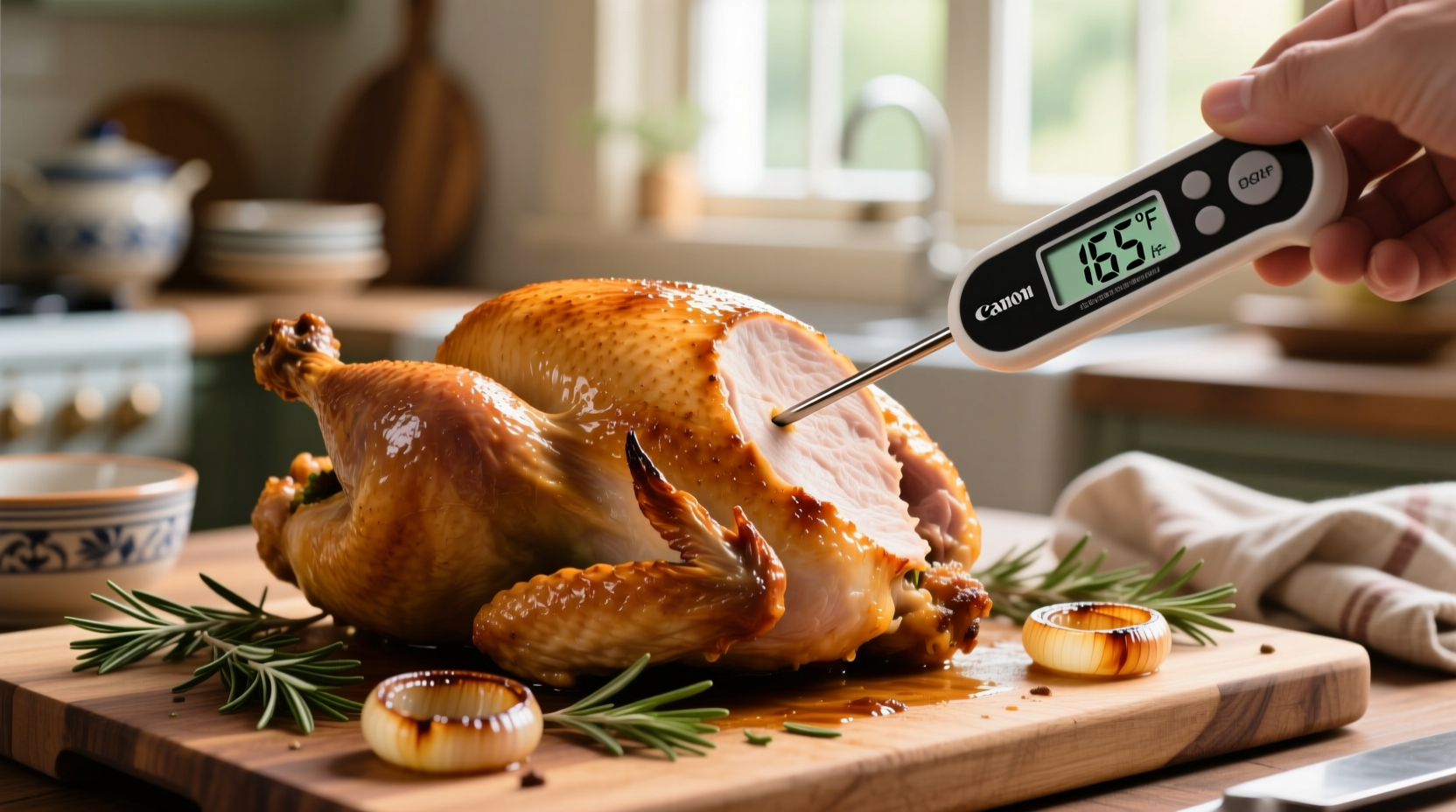Nothing ruins a holiday gathering faster than foodborne illness from improperly cooked turkey. Understanding the precise temperature requirements isn't just culinary advice—it's essential food safety knowledge that protects your family and guests. This guide cuts through common misconceptions with science-backed temperature guidelines you can trust.
Why 165°F Is the Critical Threshold
When turkey reaches 165°F internally, it achieves what food scientists call "lethality temperature"—the point where dangerous pathogens are eliminated. According to the USDA Food Safety and Inspection Service, this temperature destroys:
- Salmonella - Eliminated instantly at 165°F
- Campylobacter - Destroyed within seconds at this temperature
- Clostridium perfringens - Neutralized when proper temperature is maintained
Contrary to popular belief, color isn't a reliable indicator of doneness. The USDA confirms that turkey can appear pink even when safely cooked to 165°F due to myoglobin reactions, especially in younger birds or when using certain cooking methods.

Where and How to Take Accurate Temperature Readings
Proper thermometer placement is critical for accurate readings. Many home cooks make the mistake of checking only one spot, which can lead to dangerously undercooked sections.
| Body Part | Correct Placement | Common Mistakes |
|---|---|---|
| Thigh | Innermost part, not touching bone | Inserting near joint where temperature reads lower |
| Breast | Thickest part, avoiding fat pockets | Measuring near surface where heat penetrates first |
| Wing | Meatiest section between joint and body | Checking only the thin outer portion |
| Stuffing | Center of cavity, separate from turkey | Assuming turkey temperature equals stuffing temperature |
For best results, use an instant-read digital thermometer rather than dial thermometers, which can be off by as much as 5-10 degrees. Calibrate your thermometer regularly by testing in ice water (should read 32°F) or boiling water (212°F at sea level).
Temperature Progression During Cooking
Understanding how turkey temperature changes during cooking helps prevent both undercooking and dryness. The following timeline reflects standard oven roasting at 325°F:
- 100-120°F - Protein denaturation begins, juices start to flow
- 120-140°F - Collagen converts to gelatin, meat becomes tender
- 140-150°F - Myoglobin breaks down, pink color fades
- 150-165°F - Critical safety zone where pathogens are destroyed
- 165°F - Target temperature reached (remove from oven)
- 165-150°F - Resting period where carryover cooking occurs
Allow your turkey to rest for 20-30 minutes after reaching 165°F. During this time, the temperature will continue to rise 5-10 degrees (carryover cooking), then gradually decrease to the ideal serving temperature of 150-155°F while juices redistribute.
Special Considerations for Different Cooking Methods
While 165°F remains the universal safety standard, different cooking techniques require specific temperature monitoring approaches:
- Smoked turkey - Maintain smoker between 225-250°F; monitor internal temperature frequently as smoke can create false coloration
- Deep-fried turkey - Oil temperature must stay at 350°F; check breast temperature first as it cooks faster than dark meat
- Sous vide turkey - Can be cooked at lower temperatures (145°F for 2+ hours) but requires precise time control
- Grilled turkey - Use two-zone cooking; check temperature more frequently due to variable heat exposure
For stuffed turkeys, the USDA requires that both the turkey AND the stuffing reach 165°F. Many food safety experts recommend cooking stuffing separately to ensure proper temperature is achieved without overcooking the bird.
Common Temperature Myths Debunked
Several persistent myths about turkey temperature can compromise food safety:
- "The juices should run clear" - Not reliable; juices can appear clear before pathogens are destroyed
- "180°F is the proper temperature" - Outdated recommendation that leads to dry meat
- "If it looks done, it is done" - Visual cues are unreliable indicators of safety
- "Resting time continues to cook the turkey" - Carryover cooking only raises temperature 5-10°F, not enough to reach safety threshold if undercooked
The only reliable method for determining turkey doneness is using a calibrated food thermometer at multiple points in the bird. This practice aligns with current USDA Food Safety and Inspection Service guidelines updated in 2023 to reflect modern food safety research.
Frequently Asked Questions
Can turkey be safe at temperatures below 165°F?
While sous vide cooking can safely prepare turkey at lower temperatures (145°F for 82 minutes), conventional oven roasting requires 165°F for immediate pathogen destruction. The USDA maintains 165°F as the standard for home cooking because it provides an instant kill temperature without requiring precise time monitoring.
Why does my turkey thermometer show 165°F but the meat still looks pink?
Pink color in safely cooked turkey occurs due to myoglobin reacting with heat and nitrites, especially in younger birds. The USDA confirms that turkey can appear pink even when properly cooked to 165°F. Always rely on thermometer readings rather than color.
How long should I let turkey rest after reaching 165°F?
Allow turkey to rest for 20-30 minutes (longer for larger birds) after reaching 165°F. This resting period lets juices redistribute through the meat, resulting in moister slices. The internal temperature will continue to rise 5-10 degrees during the first few minutes of resting.
Does the 165°F rule apply to turkey parts as well as whole birds?
Yes, all turkey products—whether whole birds, breasts, thighs, or ground turkey—must reach 165°F internally. Ground turkey requires special attention as the grinding process distributes surface bacteria throughout the meat.











 浙公网安备
33010002000092号
浙公网安备
33010002000092号 浙B2-20120091-4
浙B2-20120091-4